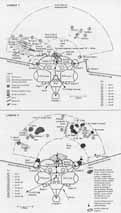















|
[29] Viking 2 went into orbit about Mars on August 7, 1976. Searching for an environment most favorable for a martian biota, a decision was made to go to higher latitudes where small amounts of H2O ice might temporarily exist in or below the surface. Once in orbit we were required to land in the vicinity of 48°N.
The entire latitude band was searched. None of the pictures was very reassuring. Concern was heightened by the awareness that at the first landing site there were several rocks in the vicinity of the Lander that could easily have destroyed it, had the touchdown point been shifted a few meters. The Project Manager decreed that the second site should be rock free-or, at least, that persuasive arguments in that direction were mandatory. As in the case of the first landing, the juggling of potential landing sites was both exhaustive and exhausting. As the landing was delayed, the optional strategies for site certification and simultaneous operation of four spacecraft became byzantine in complexity. The final decision to land on September 3 was forced less by objective knowledge that we had found a safe site than by knowledge that the flight team was running out of steam and time.
Viking 2 was targeted to 48°N, 226°W, a spot in Utopia Planitia. The name, at least, augured success. However, an undefinable pessimism preceded the second landing, strange in light of the success of Viking 1. We realized, perhaps, how quickly the euphoria of past months could change to criticism and disappointment if the second half of the total mission were unsuccessful.
The Viking 2 Lander separated from its Orbiter at 12:40 p.m. on September 3. Minutes later, telemetered data from the Lander to Orbiter abruptly stopped. The cause was uncertain, but the prospects looked dim. It was difficult to imagine that a serious communication failure essentially at the time of separation was not the expression of a more fundamental problem. Had the Lander incorrectly separated? Was it perhaps still dangling from the Orbiter? Was it hurtling toward Mars, out of control?
Within the hour it was demonstrated that the Orbiter had rolled so that its high gain antenna pointed away from Earth. It was suspected that the loss of control was due to the failure of an inertial reference power source. Fortunately there was a redundant power source. By switching to the backup the Orbiter was reoriented, but not until several hours after landing.
Meanwhile, we could track the descent of Viking 2 by using a low gain antenna on the Orbiter to monitor the signals sent by the Lander. Although little in the way of detailed data was received, the very presence of the Lander signal meant that it was operational. During an expected communication blackout immediately preceding landing, we listened as the mission controller called out "Touchdown minus seven, six, five, four, three, two, one, zero." There was a long silence. It seemed like minutes. Over the loudspeaker came a muffled prayer, "Come on, baby." Nothing. I looked down at my shoes. I remember thinking, "You always wondered what a failure would feel like. Now you know." I mentally composed some remarks for friends standing nearby. Finally, the silence was broken. "We have touchdown." Pandemonium broke loose a completely unrestrained celebration unlike the more self conscious moments following the Viking 1 landing. For a few hours, with regular communication from the Lander still not established, there was nothing much to be done. Cases of champagne magically appeared. The tight security procedures were temporarily suspended. Families trooped into the laboratories to share in the excitement. Two successful landings! It was an outcome that not even the most optimistic had looked forward to.
It was not until late that evening that regular communication with the Orbiter could be established. Now it could relay the pictures that, almost eight hours previously, had been transmitted from Lander to Orbiter just after touchdown. We were already exhausted after a long day. The event held little of the drama associated with the first Viking 1 pictures. Indeed, at first glance, the Viking 2 landscape was something of a disappointment, looking superficially like the...

[30] ...Viking 1 scene. The profusion of large blocks was the source of wry amusement. Jim Martin reminded us that we had promised a landing on undulating desert dunes.
In the subsequent weeks I revised my opinion of the Viking 2 site. It is, in fact, quite different from the first site, and the geological histories are probably dramatically diverse. Nonetheless, as the days passed by, I could feel my enthusiasm waning, the Viking experience slipping away. I looked forward to the end.
In early November the primary mission concluded. Mars passed behind the Sun and communication with the four spacecraft was temporarily impossible.
We crossed off the last few days on the calendar, just like the last days of school. The very last night I stayed late at the laboratory, writing notes to a few of the people with whom I had worked so closely for so long. The next morning my wife, youngest daughter, and I started off-a roundabout route back to Providence by way of the Sierras. We spent four days in Yosemite. The valley was virtually deserted this late in the season, the ground thickly covered with crisp aspen leaves. The Sun was rich and warm, refusing to give way to the scheduled appearance of winter. At night we could look out of our tent, across a field, to the cliffs bathed in the chalky, white light of a full Moon. When I think about Viking, my thoughts often return to that Yosemite epilogue.
